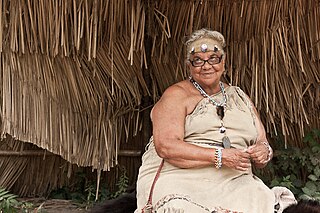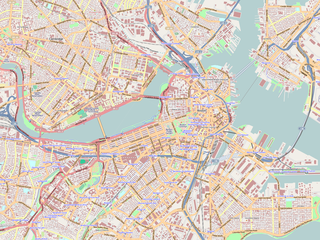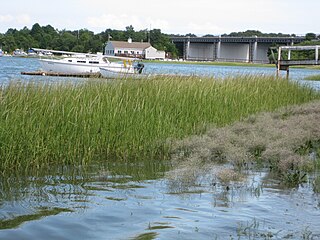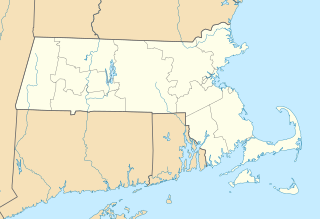
Mashpee is a town in Barnstable County, Massachusetts, United States, on Cape Cod. The population was 15,060 as of 2020. The town is the site of the headquarters and most members of the Mashpee Wampanoag Tribe, one of two federally recognized Wampanoag groups.

The Connecticut River is the longest river in the New England region of the United States, flowing roughly southward for 406 miles (653 km) through four states. It rises at the U.S. border with Quebec, Canada, and discharges at Long Island Sound. Its watershed encompasses 11,260 square miles (29,200 km2), covering parts of five U.S. states and one Canadian province, via 148 tributaries, 38 of which are major rivers. It produces 70% of Long Island Sound's fresh water, discharging at 18,400 cubic feet (520 m3) per second.

The Wampanoag, also rendered Wôpanâak, are a Native American people. They were a loose confederation of several tribes in the 17th century, but today Wampanoag people encompass five officially recognized tribes. The Mashpee Wampanoag Tribe and the Wampanoag Tribe of Gay Head in Massachusetts are federally recognized, and the Chappaquiddick, Herring Pond, Assawompsett-Nemasket Band of Wampanoags, and Pocasset Wampanoag Tribe (Pokonoket) are recognized by the Commonwealth of Massachusetts. They lived in southeastern Massachusetts and Rhode Island in the beginning of the 17th century, at the time of first contact with the English colonists, a territory that included the islands of Martha's Vineyard and Nantucket. Their population numbered in the thousands; 3,000 Wampanoag lived on Martha's Vineyard alone.

The Narragansett people are an Algonquian American Indian tribe from Rhode Island. The tribe was nearly landless for most of the 20th century, but it worked to gain federal recognition and attained it in 1983. It is officially the Narragansett Indian Tribe of Rhode Island and is made up of descendants of tribal members who were identified in an 1880 treaty with the state.

Back Bay is an officially-recognized neighborhood of Boston, Massachusetts, built on reclaimed land in the Charles River basin. Construction began in 1859, as the demand for luxury housing exceeded the availability in the city at the time, and the area was fully built by around 1900. It is most famous for its rows of Victorian brownstone homes—considered one of the best preserved examples of 19th-century urban design in the United States—as well as numerous architecturally significant individual buildings, and cultural institutions such as the Boston Public Library, and Boston Architectural College. Initially conceived as a residential-only area, commercial buildings were permitted from around 1890, and Back Bay now features many office buildings, including the John Hancock Tower, Boston's tallest skyscraper. It is also considered a fashionable shopping destination and home to several major hotels.

The Guadalupe River mainstem is an urban, northward flowing 14 miles (23 km) river in California whose much longer headwater creeks originate in the Santa Cruz Mountains. The river mainstem now begins on the Santa Clara Valley floor when Los Alamitos Creek exits Lake Almaden and joins Guadalupe Creek just downstream of Coleman Road in San Jose, California. From here it flows north through San Jose, where it receives Los Gatos Creek, a major tributary. The Guadalupe River serves as the eastern boundary of the City of Santa Clara and the western boundary of Alviso, and after coursing through San José, it empties into south San Francisco Bay at the Alviso Slough.

JFK/UMass station is a Massachusetts Bay Transportation Authority (MBTA) intermodal transfer station, located adjacent to the Columbia Point area of Dorchester, Boston, Massachusetts. It is served by the rapid transit Red Line; the Greenbush Line, Kingston/Plymouth Line, and Middleborough/Lakeville Line of the MBTA Commuter Rail system, and three MBTA bus routes. The station is named for the John F. Kennedy Presidential Library and Museum and the University of Massachusetts Boston, both located nearby on Columbia Point.

The American shad is a species of anadromous clupeid fish naturally distributed on the North American coast of the North Atlantic, from Newfoundland to Florida, and as an introduced species on the North Pacific coast. The American shad is not closely related to the other North American shads. Rather, it seems to form a lineage that diverged from a common ancestor of the European taxa before these diversified.

Arlington is a station on the light rail MBTA Green Line. located at the southwest corner of the Boston Public Garden at the corner of Arlington and Boylston Streets at the east end of the Back Bay neighborhood of Boston, Massachusetts. Arlington was not part of the 1914-opened Boylston Street subway; its construction was delayed by World War I and the station opened in 1921.

The Weymouth Back River, sometimes called Back River, is a short, primarily tidal river in Hingham and Weymouth, Massachusetts, about 10 miles (16 km) south of Boston. It arises from a number of tributaries in ponds and swamps, most notably Whitmans Pond, flows northward, and empties into Hingham Bay.
Park Square in downtown Boston, Massachusetts is bounded by Stuart, Charles Street South, Boylston, and Arlington Streets. It is the home of the Boston Four Seasons Hotel, the Boston Park Plaza, and nearly a dozen restaurants. To the north across Boylston Street is the Boston Public Garden. To the east is the Washington Street Theatre District. The Bay Village neighborhood is to the south, and Back Bay is to the west.

Boston Harborwalk is a public walkway that follows the edge of piers, wharves, beaches, and shoreline around Boston Harbor. When fully completed it will extend a distance of 47 miles (76 km) from East Boston to the Neponset River.
Ross Miller is an American visual artist. His work integrates art into the public landscape. Through site-based projects, his work reinforces community identity in outdoor spaces and creates places for private reflection within public environments.

The Patuxet were a Native American band of the Wampanoag tribal confederation. They lived primarily in and around modern-day Plymouth, Massachusetts, and were among the first Native Americans encountered by European settlers in the region in the early 17th century. Most of the population subsequently died of epidemic infectious diseases. The last of the Patuxet – an individual named Tisquantum, who played an important role in the survival of the Pilgrim colony at Plymouth – died in 1622.

In archeological literature, the name Boylston Street Fishweir refers to ancient fishing structures first discovered in 1913, buried 29 to 40 feet below Boylston Street in Boston, Massachusetts. Reports written in 1942 and 1949 describe what was thought to be remains of one large fishweir, 2,500 years old, made of up to 65,000 wooden stakes distributed over an estimated 2 hectares of the former mud flat and marshland in what is now the Back Bay section of Boston. A different interpretation of these findings is offered by new evidence and contemporary archeological research techniques.
The Mashpee Wampanoag Tribe is one of two federally recognized tribes of Wampanoag people in Massachusetts. Recognized in 2007, they are headquartered in Mashpee on Cape Cod. The other Wampanoag tribe is the Wampanoag Tribe of Gay Head (Aquinnah) on Martha's Vineyard.
Linda Jeffers Coombs is an author and historian from the Wampanoag Tribe of Gay Head (Aquinnah). Coombs is the program director of the Aquinnah Cultural Center.

Legal forms of gambling in the U.S. state of Massachusetts include casinos, parimutuel wagering on horse racing, the Massachusetts Lottery, and charitable gaming. The Massachusetts Gaming Commission regulates commercial operations under state jurisdiction.

Menemsha Pond is a salt pond split between the towns of Aquinnah & Chilmark, Massachusetts. At the mouth of the pond, the Menemsha Creek leads into the Menemsha Bight and the Vineyard Sound. Along Menemsha Creek sits the historic sea-side fishing village of Menemsha. Menemsha Pond connects to both Stonewall Pond via Nashaquitsa Pond and to Squibnocket Pond via the Squibnocket Herring Run.















